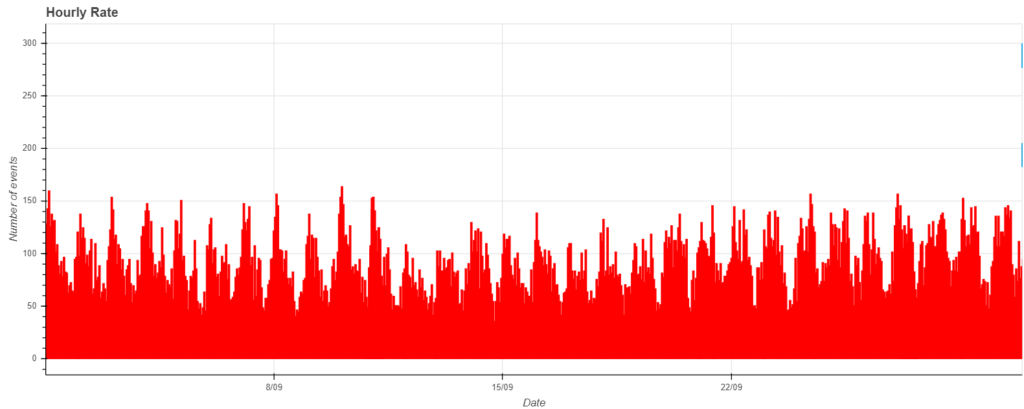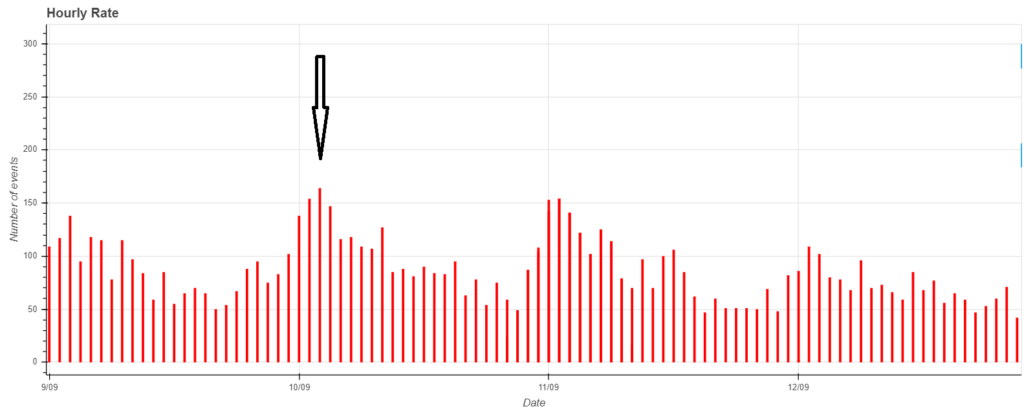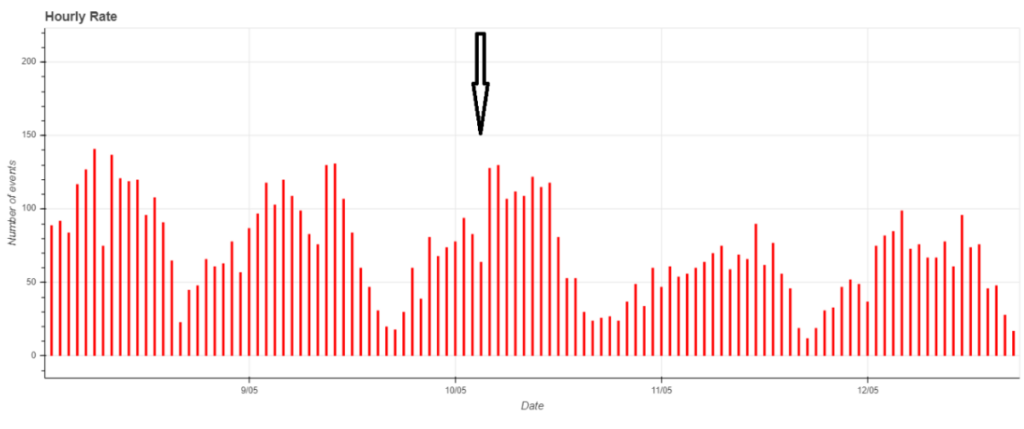Mariasole Maglione (Gruppo Astrofili Vicentini)
Lorenzo Barbieri (CARMELO network and AAB: Associazione Astrofili Bolognesi)
Introduction
The month of September 2024 offered some interesting radio meteor observations, with activity driven mainly by the ε-Perseids (208 SPE) meteor shower. This bulletin from the CARMELO (Cheap Amateur Radio Meteor Echoes Logger) network presents an analysis of events detected through radio receivers distributed among Italy, Croatia, England and the United States, particularly during the ε-Perseids (208 SPE) peak, which characterized the early part of the month.
The bulletin examines the trend of meteoric activity during the month. It also discusses some of the effects of the recent May 2024 geomagnetic storm, which affected the surveys, offering some insights and possibilities for future study.
Methods
The CARMELO network consists of SDR radio receivers. In them, a microprocessor (Raspberry) performs three functions simultaneously:
- By driving a dongle, it tunes the frequency on which the transmitter transmits and tunes like a radio, samples the radio signal and through the FFT (Fast Fourier Transform) measures frequency and received power.
- By analyzing the received data for each packet, it detects meteoric echoes and discards false positives and interference.
- It compiles a file containing the event log and sends it to a server.
The data are all generated by the same standard, and are therefore homogeneous and comparable. A single receiver can be assembled with a few devices whose total current cost is about 210 euros.
To participate in the network read the instructions on this page.
September data
In the graphs that follow, all available at this page, the abscissae represent time, which is expressed in UT (Universal Time), and the ordinates represent the hourly rate, calculated as the total number of events recorded by the network in an hour divided by the number of operating receivers.
The graph in fig.1 shows the hourly rate of radio meteor detections for the month of September 2024. The main event corresponds to the ε-Perseid (208 SPE) meteor shower, active between late August and mid-September (1). The shower peaked on September 10.
ε-Perseids
September’s ε-Perseids are less well known than large showers such as August’s Perseids or December’s Geminids. The peak produces a maximum activity of about 5-10 meteors per hour under dark sky conditions. The shower has its radiant, or the point in the sky from which the meteors appear to radiate, in the constellation Perseus, which, in the northern hemisphere, is particularly high on the horizon in the pre-dawn hours.
The graph shows a slight increase in the number of events detected in the days up to Sept. 11 (in fig. 2, a zoom on the trend in the middle part of the month).
After the peak, the graph shows a decline and finally a relatively constant background level of meteor detections, with small fluctuations mainly due to sporadic or contributions from other showers.
May 2024 auroral radio emissions and interference
During the International Meteor Conference 2024 (IMC2024) Sept. 19-22 in Kutná Hora, Czech Republic, Hervé Lamy of the Belgian Institute for Space Aeronomy gave a presentation titled “Radio emissions of auroral origin observed by the BRAMS network during the Mother’s Day geomagnetic storm” (2), during which he presented a study of geomagnetic activity during geomagnetic storms and its impact on radio detection networks such as the Belgian BRAMS.
Geomagnetic storms, such as the particularly intense one that occurred between May 10 and 12, 2024, occur when coronal mass ejections (CMEs) interact with the Earth’s magnetic field, causing changes in the ionosphere that affect radio transmission. Radio emissions associated with the aurora, mainly at VLF frequencies (3-30 kHz), but also HF and VHF (between 30 and 300 MHz), disrupt radio wave propagation (3), (4).
In addition, in conjunction with strong coronal mass emissions, it is conceivable that the degree of ionization of the ionosphere increases implying the presence of more free electrons. It can be hypothesized that the ionization efficiency due to the meteor phenomenon is therefore lower, resulting in fewer detected meteors.
During the geomagnetic storm of May 10-12, 2024, the BRAMS network detected a reduction in meteor signals, as illustrated by Lamy. We checked the behavior of the CARMELO network from days before to days after the May storm to see if it was in agreement with what Lamy reported. The graph in fig. 3 shows the trend of signals detected during that period.
It shows a reduction in the number of signals received on May 11 at 3 UT at the peak of the storm.
Auroral radio emissions, however, as pointed out in a 2023 study by James LaBelle (5), still present both theoretical and experimental open challenges, including understanding their frequency, temporal structure, and relationship to auroral phenomena. Key parameters such as source heights or generation mechanisms remain uncertain. However, technological advances, such as the use of cubesats and dedicated missions, are paving the way for improved remote sensing and understanding of auroral emissions, providing new opportunities to monitor the ionosphere and improve the sensitivity of radio receiver networks, such as CARMELO.
The CARMELO network
The network currently consists of 14 receivers, 13 of which are operational, located in Italy, the UK, Croatia and the USA. The European receivers are tuned to the Graves radar station frequency in France, which is 143.050 MHz. Participating in the network are:
- Lorenzo Barbieri, Budrio (BO) ITA
- Associazione Astrofili Bolognesi, Bologna ITA
- Associazione Astrofili Bolognesi, Medelana (BO) ITA
- Paolo Fontana, Castenaso (BO) ITA
- Paolo Fontana, Belluno (BL) ITA
- Associazione Astrofili Pisani, Orciatico (PI) ITA
- Gruppo Astrofili Persicetani, San Giovanni in Persiceto (BO) ITA
- Roberto Nesci, Foligno (PG) ITA
- MarSEC, Marana di Crespadoro (VI) ITA
- Gruppo Astrofili Vicentini, Arcugnano (VI) ITA
- Associazione Ravennate Astrofili Theyta, Ravenna (RA) ITA
- Akademsko Astronomsko Društvo, Rijeka CRO
- Mike German a Hayfield, Derbyshire UK
- Mike Otte, Pearl City, Illinois USA
The authors’ hope is that the network can expand both quantitatively and geographically, thus allowing the production of better quality data.
References
(2) Hervé Lamy (2024): “Radio emissions of auroral origin observed by the BRAMS network during the Mother’s Day geomagnetic storm”. International Meteor Conference 2024
(3) S.B. Sigh, K. Patel, A.k. Sigh (2018): “Effect of geomagnetic storms on VHF scintillations observed at low latitude”. Journal of Astrophysics and Astronomy, vol. 39, n.36
(4) HF Radio Communications – Space Weather Prediction Center NOAA
(5) James LaBelle (2023): “Radio emissions of auroral origin observable at ground level: outstanding problems”. Frontiers in Astronomy and Space Sciences, vol.10




